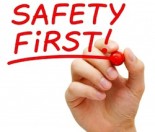Bunk beds can be a great way of saving space in bedrooms but it’s important to make sure that they are safe for your children. Every year, over 100 New Zealand children are injured in accidents relating to bunk beds, so it’s important to take some precautions and perform some safety checks.
You can also listen to Kiwi Families editor, Rochelle, talking to Paul Henry about bunk bed safety.
Here are some tips for keeping your children safe in bunk beds.
Tips for using bunks safely : What to look for – safe design and construction : More information
Tips for using bunks safely
- Make sure that all parts of the bunk are firmly attached – especially the guard rail and the ladder. Check these regularly.
- Teach your children that the way to climb up and down to/from the top bunk should be exclusively by using the ladder.
- Check for sharp edges or protrusions which might catch clothing and create a strangling risk, and ensure there is nothing poking out from a wall that can cause injury. Never hang anything from the bunks such as scarves or belts.
- Metal tubular bunks should have ends plugged.
- The mattress must always fit the frame so that there are no spaces where a child’s arm, leg or head can become trapped. Check the recommended mattress size for the bed you have bought.
- Be careful where you place the bed. Don’t create a space between the bed and a wall which could trap a small child. Preferably line the beds up in a corner of the room – against two walls.
- Ensure the bunk bed is in a safe position within the room/immediate area – keep bunk beds away from other items of furniture that children may be tempted to try and climb onto. Discourage children from playing with toys around the bunks to reduce risk if a child jumps or falls from the bed(s).
- Keep bunk beds away from windows. Allow a space of at least two metres from ceiling fittings, fans or lights.
- Make sure curtain and blind cords are not accessible to children from the bunk bed.
- Use the top bunk only for sleeping. Falls while playing on the top bunk make up most of the injuries. Discourage children from playing on the top bunk and keep an eye on this when possible.
- Check regularly for wear and tear. Always repair any damage immediately.
- Pay particular attention when using bunk beds that are not familiar to you (for example in holiday accommodation).
What to look for – safe design and construction *
(for more details refer to AS/NZS 4220:2010)
Guardrails
Look for bunk beds with guardrails or bed-ends on all sides of the top bunk.
Guardrails should be either non detachable or if detachable then they should be incapable of being moved by a force of 500 N in any direction.
The minimum vertical distance between the top of the guardrail and top of the mattress base should be not less than 360mm.
Guardrails should be smooth and free from protrusions or potential snag points.
If there is an opening to provide easier access to the bed then the opening should have a minimum width of 300mm and a maximum of 400mm.
Gaps
Check that there are no gaps of 95mm to 230mm in any part on the bunk beds, including guardrails and rungs on ladders.
Small bodies can fit through but heads can get stuck.
Protrusions
Check that there are no protrusions from the bunk bed more than 5mm. Anything sticking out from the bunks could catch clothing and create a strangling risk.
Make sure all nuts, bolts and other fasteners on bunk beds are flat or recessed and smooth and do not create a sharp point, edge or snag hazard.
More information
* For further information, see Ministry of Consumer Affairs information on Bunk Beds






